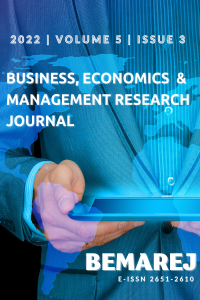Research Article
Issue Editorial Board



Gökhan AKEL, Lisans eğitimini Pamukkale Üniversitesi, İktisadi ve İdari Bilimler Fakültesi İşletme Bölümü’nde, Yüksek Lisans eğitimini Pamukkale Üniversitesi, Sosyal Bilimler Enstitüsü Üretim Yönetimi ve Pazarlama Bölümü’nde, Doktora eğitimini ise Aydın Adnan Menderes Üniversitesi Sosyal Bilimler Enstitüsü İşletme Programında tamamlamıştır. 2017 yılından itibaren Antalya AKEV Üniversitesi’nde görev yapmaktadır. Antalya AKEV Üniversitesi bünyesinde Sürekli Eğitim Uygulama ve Araştırma Merkezi Müdürlüğü ve Uzaktan Eğitim Merkezi Müdür Yardımcılığı faaliyetlerinde bulunmuş olup, halihazırda Erasmus Koordinatörlüğü ve Dekan Yardımcılığı görevlerini yürütmektedir. Kariyeri boyunca, Türkiye’de ve yurtdışında hem özel sektörde hem de akademik açıdan çalışmalar ve faaliyetlerde bulunmuştur.
Aim & Scope
The aim of Business, Economics and Management Research Journal – BEMAREJ; to contribute to the national and international social sciences literature by including studies based on original researches in social sciences in general, and in particular in business, economics and management sciences.
Business, Economics and Management Research Journal – BEMAREJ is a peer-reviewed, tri-annual (March - July - November) academic publication. All scientific papers based on original research and have directly or indirectly relation with social sciences in general and with business administration, economics and public administration in particular are published in the Journal. Besides these papers, which are the main scope of the Journal, within the same fields of study; those papers are also published in the Journal: Reports, articles in similar scientific nature, case studies, off the ground papers other than articles, etc. In this context, the Journal is open to articles related with economics, business administration, public administration, political science, international relations, finance, econometrics and management information systems and other papers on issues of various disciplines mainly from those fields of science: philosophy, psychology, sociology, law and communication. The authors may contribute to the Journal with their text prepared in accordance with the rules determined by the editorial board. Those texts can only be in one of the following languages: Turkish and English. The Journal may also be published in the electronic media through decision made by the Editorial Board.
Author Guidelines
- Only Turkish and English texts are accepted at BEMAREJ.
- The texts sent to for the publication should not be previously published or sent for publication in another journal or congress.
- Full text should be prepared in Microsoft Office Word format with APA Style 7th Edition.
- The text will fit into following dimensions: A4 size paper, top: 2,5 cm, bottom: 2,5 cm, left: 2 cm, right: 2 cm, header: 1,25 cm, footer:1,25 cm.
- Whole text must be written in 11 pt Times New Roman, 6 pt spacing before and after, single-spaced. The text written in the specified format should not exceed 25 pages.
- First page should be written in the following format:
Title : 14 pt, bold, centered, 12 pt before and 6 pt after spacing, all letters capitalised, and consisting of 12 words maximum.
Author(s) : 10 pt, centered, spaced 6pt before and 6pt after, Corresponding author, address of the institution/university and e-mail information should be indicated in footnote. Multiple authors’ names should be written one under the other. Footnotes should be in numbers consecutively.
Abstract : should be
without first-line indent (9 pt, 6 pt spacing before and after,
justified) should not exceed 250 words.
Keywords: (9 pt, 6 pt before & after spacing) following
the title ‘Keywords:’ divided with comma.
Keywords: MCDM, SWARA
JEL codes : Compulsory
in fields related to business management and economics. “JEL Codes:” (9 pt,
bold, 6 pt before & after spacing) following the title after colon. For
specifing the appropriate JEL code, please refer to
http://www.aeaweb.org/journal/jel_class_system.
JEL Codes: C44, M00
- The following rules are applied to the text which should have only the title and the abstract in the first page:
Titles : 11 pt, bold, left-aligned, 12 pt before & 6 pt after spacing. Capitalisation should be done as follows:
1. Introduction
2. Title 1
2.1. Subtitle
3. Title 2
3.1. Subtitle
3.1.1. Subtitle subtitle
4. Conclusion
References (No heading number)
Paragraphs : Times New Roman, 11 pt, justified, 6 pt before & 6 pt after spacing. No first-line indent is used in the beginning of the paragraphs.
Tables & Diagrams and Charts, etc.: Calibri, 10 pt, bold and left-alligned. Heading numbers should be used (i.e. Table 1: ….., Figure 3: …..). Table titles should be written above the table, and titles of figures and diagrams should be located below them. The font in the diagrams, figures and charts should be between 9 pt and 11 pt.
- In the text;
§ Decimals should be divided with comma..
§ Sequence numbers given to the equations must be in brackets, on the right side of the page.
§ For the entries of mathematical equations and formulas, either formula editor of MS Word or MathType can be used.
§ Equations, figures, tables etc. should be explained in the text.
§ If necessary, the reference for charts, figures, tables etc. should be just beneath them following the title ‘Source:’
- APA-style citation is advised. So, author’s surname, date, and page numbers should be mentioned in in-text references. For three and more authors, the term ‘et al.’ should be used. Reference samples are as follows:
(Işığıçok, 2011b: 8-10)
(Poklepović & Babić, 2014)
(Opricovic &
Tzeng, 2004: 448).
(Bendel, 2005; Erdem & Kavrukkoca, 2002: 15; Timor, 201: 45)
(Gavcar et al., 2011: 15)
Kurnaz, Çetinoğlu and Yaşa (2011)
Womack and Jones (2003)
Kaya (2009) or (Kaya, 2009)
Sample references for journals and conferences:
Bendell, T. (2005). Structuring business process improvement methodologies. Total Quality Management & Business Excellence, 16(8-9), 969–978. https://doi.org/10.1080/14783360500163110.
Kurnaz, N., Çetinoğlu, T., & Yaşa, İ. (2011). Yerel yönetimlerde performans değerlendirmesi için dengeli ölçüm kartının kullanılması: Kütahya belediyesinde bir uygulama. Çağdaş Yerel Yönetimler, 20(4), 25–56.
Opricovic, S., & Tzeng, G. H. (2004). Compromise solution by MCDM methods a comparative analysis of VIKOR and TOPSIS. European Journal of Operational Research, 156(2), 445–455. https://doi.org/10.1016/S0377-2217(03)00020-1
Poklepović, T., & Babić, Z. (2014). Stock selection using a hybrid MCDM approach. Croatian Operational Research Review, 5, 273–290. https://doi.org/10.1016/S0377-2217(03)00020-1.
Sample citations for books and theses:
Albayrak, B. (2009). Proje yönetimi ve analizi. Nobel Yayın Dağıtım.
Sengupta, R. N., Gupta, A., & Dutta, J. (2017). Decision Science: Theory and Practice. CRC Press Taylor & Francis Group.
Heyd, W. (2001). Yakın-Doğu ticaret tarihi (Çev. E.Z. Karal). Türk Tarih Kurumu.
Işığıçok, E. (1993). Değişkenler arasındaki ilişkilerin araştırılmasında nedensellik testleri ve bir uygulama denemesi (Unpublished doctoral dissertation). Uludağ Üniversitesi Sosyal Bilimler Enstitüsü, Bursa, Türkiye.
Işığıçok, E. (2011a). Altı sigma kara kuşaklar için hipotez testleri yol haritası. Marmara Kitabevi.
Işığıçok, E. (2011b). 100 soruda altı sigma. Marmara Kitabevi.
Karluk, S. R. (2005). Kıbrıs’ın AB üyeliği AB’yi böler mi?. Oğuz Kaymakçı (Ed.). Avrupa Birliği Üzerine Notlar (s. 263-287). Nobel Yayın Dağıtım.
Timor, M. (2011). Analitik hiyerarşi prosesi. Türkmen Kitabevi.
Womack, J. P., & Jones, D.T. (2003). Lean thinking. Productivity Press.
For internet sources
Devlet Planlama Teşkilatı Müsteşarlığı. (2006). Dokuzuncu kalkınma planı. https://pbk.tbmm.gov.tr/dokumanlar/kalkinma-plani-9-genel-kurul.pdf.
Erdem, S., & Kavrukkoca, G. (2002). Sürekli iyileştirme projelerinin seçiminde analitik hiyerarşi süreci’nin kullanımı. Whttp://www.deu.edu.tr/userweb/sabri.erdem/dosyalar/AHP.pdf.
Kaya, İ. (2009, Aralık 22). Postmodern marketing / Postmodern pazarlama. Pazarlama Bi’tanedir. Website: http://pazarlamabitanedir.blogspot.com.tr/2009/12/postmodern-marketing-postmodern.html.
Ethical Principles and Publication Policy
In terms of publication ethics BEMAREJ pursues the principles, standards and recommendations of the publication ethics determined by COPE (Committee on Publication Ethics) and ICMJE (International Committee of Medical Journal Editors). Accordingly, all the articles that do not comply with the accepted standards of ethics are rejected. The rule also applies for those articles that contains discrepancies which are detected after the publication. In the context of publication ethics, all the shareholders are expected to bear the following ethical responsibilities in brief and all the ethical incidences are going to be evaluated in compliance with COPE rules.
Ethical Responsibilities of Authors:
Authors should send those articles which have not been published elsewhere or which have not been sent anywhere.
Authors should give references to all the citations in their articles.
Authors are accepted to declare that the article belongs to themselves, they do not plagiarise, all the responsibilities due to plagiarism belong to themselves and the journal does not have any responsibility in such cases.
Authors should guarantee that they give scientific contribution to the article and it should be accepted that all the authors of the article have equal responsibility.
Corresponding author should guarantee that all the co-authors mentioned in the article have an agreement on the publication of the article and on being named as co-authors. All the writers who give crucial contributions to the article should be named as co-authors. Others should be given place in the acknowledgement.
Authors are responsible for declaring the supporting institutions, financial sources or conflicts of interest.
In case of necessity authors should give access to the data sets utilised in the articles.
The authors should prepare the articles to be published in the Journal in accordance with research and publication ethics. For the research made in the article and for clinical and experimental studies on human and animal that necessitate ethics committee approval separate ethics committee approvals should be taken and these approvals should be mentioned in the article and should be documented.
Ethical Responsibilities of Reviewers:
Any reviewer who is selected for reviewing the article but whose qualifications do not match with the subject of the article and/or to whom the time limitation of the review process is not appropriate should inform the editor and ask for her/his removal from the review process.
Reviewers are responsible for the concealment of the articles they received and for not using the information attained from the reviewing process for personal interests.
Reviewers should not share their evaluations reports or information about the article with others and should not directly communicate with the authors without the permission of the editor.
Reviewers should be intentive about potential ethical incidences in the article and should present them to the editor. This includes similarities and overlappings with the studies of the reviewer published elsewhere.
Reviewing should be done objectively. Personal criticisms should be avoided and the evaluations should be constructive, honest and polite.
Reviewers who may have potential conflict of interest with (at least) one of the authors due to a competitive, collaborative of other types of relationships or connections should inform the editor before accepting the reviewing process.
Ethical Responsibilities of Editorial Board:
The decision of the selection of articles to be published in the Journal is under the responsibility of the editorial board. The editorial board should carry out the evaluation independent of race, gender, sexual orientation, religious belief, ethnic origin, citizenship or political philosophy. The decision to be made should be based on the accuracy, validity and importance of the article, and its relevance with the scope of the Journal. Legal necessities should also be consulted in cases of slander, copyright infringement and plagiarism.
The editor or any member of the editorial board should not reveal any information about the article except for the related authors, reviewers, potential reviewers, other editorial consultants and publishers.
The information in any article presented but not published should not be used in any research of the editor or of the member of the editorial board without express written permission of the authors.
Price Policy
Business, Economics and Management Research Journal is an Open Access Journal and does not charge any printing costs from authors, during article delivery, assessment and printing stages.
The texts to be sent to our journal should be prepared according to the template file linked below. You can also download the template file and make corrections on it. Articles that are not prepared in accordance with the template file are returned to the author by the editor.







